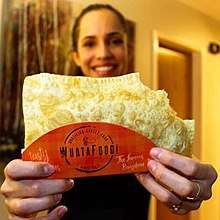Pastel (food)
Pastel is the Spanish and Portuguese word for pastry and is the name given to different typical dishes of many countries that speak or spoke those languages.
Brazil
 Cheese pastel made in São Paulo | |
In Brazil, pastel (plural: pastéis) is a typical fast-food Brazilian dish, consisting of half-circle or rectangle-shaped thin crust pies with assorted fillings, fried in vegetable oil. The result is a crispy, brownish fried pie. The most common fillings are ground meat, mozzarella, catupiry, heart of palm, codfish, cream cheese, chicken and small shrimp. Pastéis with sweet fillings such as guava paste with Minas cheese, banana and chocolate also exist. The pastel is classified in Brazilian cuisine as a salgado (savoury snack). It is traditionally sold on the streets, in open-air marketplaces, or in fast-food shops known as pastelarias. It is popularly said to have originated when Japanese immigrants adapted Chinese fried wontons to sell as snacks at weekly street markets. A common beverage to drink with pastéis is caldo de cana, a sugarcane juice.[1][2]
Portugal
A pastel in Portugal may refer to several types of desserts or hors d'œuvres. These include the pastel de bacalhau and the pastel de nata.
Spain
Pastel is typically a Spanish word that means cake, but can refer to very different dishes, popular in other Hispanic countries.
Puerto Rico
In Puerto Rico, pastel is a dish which includes diced pork with olives, capers, raisins, chickpeas, and sweet peppers. This mixture is centered in dough made mainly of green bananas with a small portion of plantain, yautía, and potato. The dough is tinted with annatto oil. It is wrapped in plantain leaf, tied with string, boiled and later served with arroz con gandules (yellow-rice with pigeon peas). The overall effect is very similar to Mexican and Peruvian tamales.
The Philippines
In the Philippines, pastel may refer to any (usually chicken or meat) casserole dish baked in a pie crust. Among Muslim Filipinos, pastel is an alternative spelling of pastil, which refer to two different dishes. Pastil (also spelled patil, patel, or patir) among the Danao-speaking peoples refers to white rice and meat wrapped in a banana leaf; while pastil among the Tausug people refers to a nativized version of the empanada.
In the province of Camiguin, however, it refers specifically to pastel de Camiguín, a soft, sweet filled bun.
Indonesia
Indonesian pastel, pie crust filled with meat and vegetables. | |
In Indonesia pastel refer to pie of crust made of thin pastry filled with meat (usually chicken) mixed with vegetables (chopped carrot and beans), rice vermicelli and sometimes egg, then deep fried in vegetable oil. It is consumed as snack and commonly sold in Indonesian traditional markets.[3] The similar Manadonese version replace thin flour pie crust with bread and filled with spicy cakalang (skipjack tuna) is called panada.
Canada
On the west coast of Canada, in Richmond, the Brazilian Pastel had a great acceptance by the Asian community, first introduced in Richmond in one of the biggest fairs in North America the Richmond Night Market by Whatafood a local company based in Vancouver - BC the pastel became one of the most popular food options of the traditional fair.
At the fair is possible to find the pastel in four flavors Beef, Cheese, Chicken and Pork Calabrese Stile (Smoked Pork Sausage).

See also
References
| Wikimedia Commons has media related to Pastéis do Brasil. |
- Lira, Adriano (2016-01-20). "Conheça a história do pastel e aprenda receitas". Casa e Jardim. Retrieved 2018-04-18.
- "A história do pastel do Beto". Correio Braziliense. 2015-07-06. Retrieved 2018-04-18.
- "Benhil Market, "Takjil" Heaven". Tempo.co. 13 July 2013.